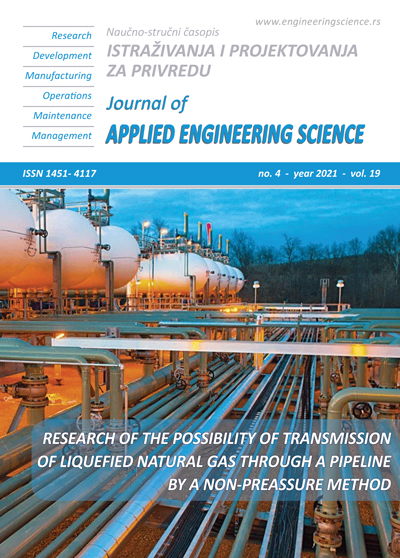A MATHEMATICAL APPROXIMATION TO LEFT-SIDED TRUNCATED NORMAL DISTRIBUTION BASED ON HART’S MODEL
APPROXIMATION TO LEFT-SIDED TRUNCATED NORMAL DISTRIBUTION
Abstract
Left-sided truncated distributions (LSTD) have been found in different situations in the industry. For example, the life distribution of used devices is left-sided truncated distribution. Moreover, if a lower specification exists without the upper specification limit, the product distribution is truncated from the left side. Left-sided truncated normal distributions (LSTND) is a special case where the original distribution is normal. LSTND characteristics, as well as cumulative densities and probabilities can be difficult to employ manually, with most practitioners relying largely on specialized (and expensive) software. In many cases, practitioners are against purchasing software, as they are often limited in the number of estimations. The paper will provide an accurate and straightforward approximation to the cumulative density of LSTND. Hart’s normal distribution is simplified and used as a foundation of this model. The maximum absolute error for the curve at different truncation points (i.e., ZL) over the definition range (i.e., [zL: ∞]) is as follows: 0.004303 for ZL=-4, 0.00432 for ZL=-3, 0.00449 for ZL=-2, 0.005727 for ZL=-1, and 0.0106 for ZL=0. Even the maximum errors are very ignorable in probability applications. Further, it is rare to find a truncation point of higher than -2 in the industry.
References
[2] Khasawneh, M.T., Bowling, S.R., Kaewkuekool, S., Cho, B.R. (2005). Tables of a Truncated Standard Normal Distribution: A Singly Truncated Case. Quality Engineering 17:33–50.
[3] Cohen, A.C. 1991. Truncated and Censored Samples: Theory and Applications, 1st Ed., Marcel Dekker, New York.
[4] Elandt-Johnson, R.C., and Johnson, N.L. 1999. Survival Models and Data Analysis, Wiley Classics Library Edition, New York.
[5] Bhattacharya, S.K., Chaturvedi, A., Singh, N.K. 1999. Bayesian Estimation for the Pareto Income Distribution. Statistical papaers 40: 247–262.
[6] Horrace, W.C. 2005. On Ranking and Selection from Independent Truncated Normal Distributions. Journal of Economics 126: 335–354.
[7] Horrace, W. C. 2015. Moments of the truncated normal distribution. Journal of Productivity Analysis 43(2): 133-138.
[8] Dueker, M. 2006. Kalman Filtering with Truncated Normal State Variables for Bayesian Estimation of Macroeconomic Models. Economics Letters 93: 58–62.
[9] Jawitz, J. W. 2004. Moments of Truncated Continuous Univariate Distributions. Advances in Water Resources 27: 269–281.
[10] Caoa, P, Miwab, T., Morikawac, T. 2014. Modeling Distribution of Travel Time in Signalized Road Section Using Truncated Distribution. Procedia Social and Behavioral Sciences 138: 137 – 147.
[11] Kantar, Y. M., Usta, I. 2015. Analysis of the Upper-Truncated Weibull Distribution for Wind Speed. Energy Conversion and Management 96: 81-88.
[12] Liquet, B., Nazarathy, Y., 2015. A Dynamic View to Moment Matching of Truncated Distributions. Statistics and Probability Letters 104: 87-93.
[13] Hoffmann, M., Vetter, M. 2016. Weak Convergence of the Empirical Truncated Distribution Function of the Lévy Measure of an Itō Semimartingale. Stochastic Processes and their Applications 127(5): 1517-1543. Aludaat, K.M., Alodat, M.T. 2008. A Note on Approximating the Normal Distribution Function. Applied Mathematical Sciences, 2, pp. 425 – 429.
[14] Sakaguchi, A., Yasuhara, K., Kimura, H. 2015. Application of a Truncated Distribution for Tsumugi Width. Textile Research Journal 85(9): 929-935.
[15] Cadwell, J.H. 1951. The Bivariate Normal Integral. Biometrika 38: 475-479.
[16] Polya, G. 1945. Remarks on Computing the Probability Integral in One and Two Dimensions. Proceedings of the 1st Berkeley Symposium on Mathematical Statistics and Probability 63-78.
[17] Lin, J.T. 1989. Approximating the Normal Tail Probability and its Inverse for use on a Pocket-Calculator. Journal of Applied Statistics 38:69-70.
[18] Hart, R.G.A. 1963. Close Approximation Related to the Error Function. Mathematics of Computation 20: 600-602.

